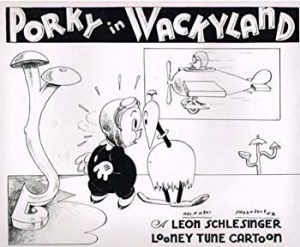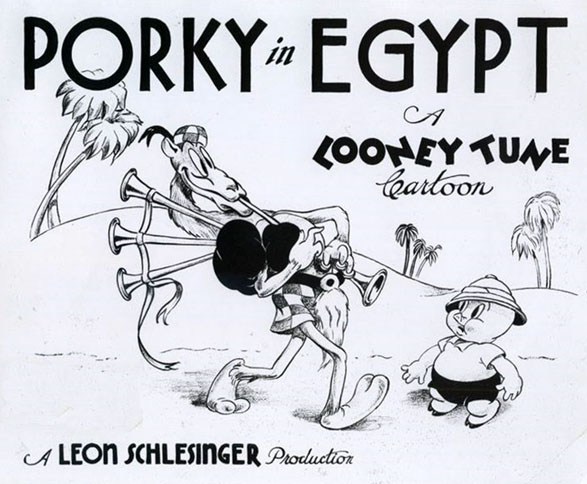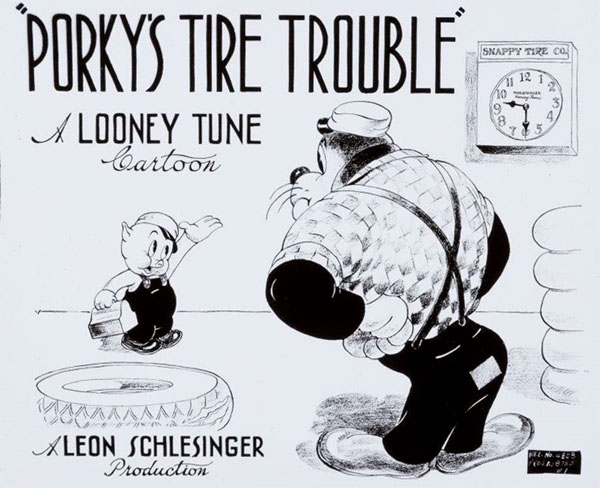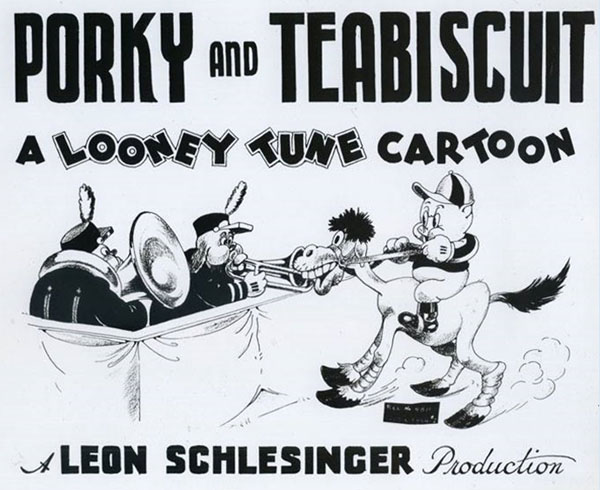 For the 1938-39 film season, there were about twice as many Merrie Melodies produced in color as there were Looney Tunes in black and white. We don’t know if that means the public or the exhibitors favored the color product over the black and white, but, that’s what the numbers show.
For the 1938-39 film season, there were about twice as many Merrie Melodies produced in color as there were Looney Tunes in black and white. We don’t know if that means the public or the exhibitors favored the color product over the black and white, but, that’s what the numbers show.
Porky in Wackyland (9/24/38) – What a way to start a season! Bob Clampett’s surreal vision, full of gags and full of pep. Most cartoon fans have seen it and treasure it. Porky travels to dark, darker, and darkest Africa for the incredibly rare “last of the dodos”, for a reward sum that doesn’t spare the zeroes. The slogan of Wackyland is taken from a cautionary book that reported that America could become a fascist country: “It can happen here!” Songs: William Tell Overture – Calm, and “Feelin’ High and Happy”, a swing number recorded by Benny Goodman (Victor), Gene Krupa (Brunswick), and “Hot Lips” page (Bluebird).

Porky’s Naughty Nephew (10/16/38) – Porky goes on a picnic with his naughty nephew Pinky, whose only interest appears to be mischief. There is a swim race, which devolves into a series of celebrity caricatures (such as Eddie Cantor, father of five daughters, getting excited over a “buoy”), and every means of cheating possible. Pinky turns the tables with a wind-up toy sailboat masquerading as a shark fin, bringing about Porky’s victory. But the “fin” turns out to be all too real when pulled out of the water. Songs include “Animal Fair”, “Japanese Sandman”, “Daddy’s Boy”, and “The Latin Quarter” from Gold Diggers Go To Paris, the final installment in said series of features.
“Latin Quarter” was introduced in the film by Freddie “Schnickelfritz” Fisher, a midwestern polka band whose performances anticipated the approach that Spike Jones would later take to music in his “Musical Depreciation Revues”, and recorded by Fisher for Decca. It was also recorded by the film’s star, Rudy Vallee, for Victor. The number became Carl Stalling’s go-to cue whenever he wanted to suggest Paris – for example, providing production numbers for Daffy Duck in both Daffy Duck Hunt (1949) and Daffy’s Inn Trouble (1961).

Porky In Egypt (11/5/38) – Porky travels into the Egyptian desert on his camel, Humpty Bumpty. A particularly vicious sun affects them both with “the Desert Madness”. Songs: “Vision of Salome”;“The Campbells Are Coming” (allowing for a musical pun between “Campbells” and “camels”); there’s also that number which I can only refer to as “Woo Woo” or the unofficial “Bugs’ Bunny” theme song, used in the Merrie Melodie, “Hare-Um Scare-Um” and later finding its way into several other cartoons over the years. “Garden of the Moon”, title song of a Warner musical starring John Payne and Pat O’Brien, was recorded by Skinnay Ennis (who had just left Hal Kemp to go out on his own) on Victor. It’s familiar cartoon used in several cartoons. Here’s Jimmy Dorsey’s version:
The Daffy Doc (11/26/38) – Daffy Duck runs riot in a hospital setting, after getting kicked out of an operation by his superior, Dr. Quack. He seeks out his own patient – with a mallet, and attempts to operate on Porky Pig with a large saw. An iron lung also provides a running visual gag, inflating various parts of the stars’ anatomies randomly. The musical score includes “Love Is On the Air Tonight”, “You Go To My Head” (used for the iron lung sequences), recorded by Larry Clinton on Victor with vocal by Bea Wain, “Frat”, and “Something Tells Me” (lyrics by Johnny Mercer, recorded by Fats Waller on Victor and Kay Kyser on Brinswick).

Porky the Gob (12/17/38) – Porky as a sailor, assigned to a ship chasing a pirate submarine (labeled “Sub-Zero”). As in other Porky service comedies of the period, Porky winds up covered in glory – and gold. Music includes “Song of the Marines”, “My Bonnie Lies Over the Ocean”, and “Columbia, the Gem of the Ocean”.

The Lone Stranger and Porky (1/7/39) – A takeoff on the popularity of The Lone Ranger radio series, first introduced on WXYZ from Detroit six years earlier, and which also hit theatre screens in a highly-regarded Republic serial the previous year. The only song recognized in the score is “Ride, Tenderfoot, Ride”, introduced by Dick Powell in Cowboy From Brooklyn and recorded by him for Decca, and also covered by Dick Todd (the “Canadian Crosby”) for Victor.

Porky’s Tire Trouble (2/18/38) – Porky works at the plant of the “Snappy Rubber Company”. Porky’s dog, Flat Foot Flookey, tags along, even though the boss doesn’t like dogs. Flookey runs afoul of a rubberizing solution, which allows for a number of elasticity gags (including the dog morphing his face into caricatures of Edward G. Robinson, Edna Mae Oliver, Clark Gable, and Hugh Herbert). Several well-known nursery rhymes are worked into the score, coupled with “Mutiny in the Nursery” (which we will discuss in a later article with relation to a Merrie Melodie that makes fuller use of the complete tune), and “You Must Have Been a Beautiful Baby”, from the Warner feature Hard To Get (1938), recorded by Bing Crosby accompanied by Bob Crosby’s orchestra on Decca. Tommy Dorsey and the Clambake Seven recorded it for Victor. And the song even saw revival in the sixties, with Bobby Darin adapting it to a twist beat for ATCO records.
Porky’s Movie Mystery (3/11/39) – A phantom is terrorizing Hollywood, and the call goes out for help from Mr. Motto (Porky Pig in “yellow-face”), a parody of the detective character “Mr. Moto”, written by John P. Marquand, and featured in a series of Fox pictures starring that “eminent Asiatic actor” – Peter Lorre (?). Mr. Motto (with the help of some “anti-invisible juice”) discovers the Phantom to by Hugh Herbert, who himself was parodied often enough in Warner cartoons. Songs include “Jeepers Creepers”, introduced in the Warner film, Going Places, the last of the Dick Powell musical series for Warner. Louis Armstrong (who performs it in the film) recorded the umber for Decca, who also issued a version by Paul Whiteman with Jack Teagarden and the four Modernaires. Also included was “You Must Have Been a Beautiful Baby”, “Japanese Sandman”, and “My Isle of Golden Dreams”, revived in the same year by Bing Crosny on Decca.

Chicken Jitters (4/1/39) – Here we have Porky running a poultry farm again, defending his flock against the depridations of a menacing fox. Some gags from Porky’s Poulry Plant make reappearances, including the shot of Porky snake-chaming worms for the chicks’ breakfast – a shot which obviously didn’t fit due to the use of the early Frank Tashlin “fat” Porky model. Songs: “Chicken Reel”, “The Old Apple Tree”, and “You Must Have been a Beautiful Baby”. The tune under the first scene is a Stalling favorite: “Monday Morning”.

Porky and Teabiscuit (4/22/39) Porky ends up with a trombone loving nag and enters him in a race. The track is filled with all the horse racing and western tunes you might expect from Stalling: “The Old Gray Mare”, “Ride Tenderfoot, Ride”, “Sabre and Spurs” (by Sousa) and Zamecnik’s “Western Scene” and “In The Stirrupps” (below). And of course the cartoon begins with a hayseed favorite “Rural Rhythm”.
Kristopher Kolumbus Jr. (5/3/39) – A retelling of Columbus’s voyage tropes, right down to Queen Isabella hocking her jewels to finance the voyage. Porky brings back several of the native Americans, who perform their traditional “war dance” for the queen – as a jitterbug free-for-all. Songs: “Let That Be a Lesson To You”, “Blow the Man Down”, “Dixie”, “Fingal’s Cave” from Mendelssohn’s “Hebrides Overture” (which would later become Chuck Jones’s go-to cue for all appearances of the Mynah Bird in the “Inki” series), “Jeepers Creepers”, and “Let’s Rub Noses”, more prominently featured in the next cartoon discussed below.
Polar Pals (6/3/39) – Another musical revue set in the frozen North. Porky has to shield the local fauna from “I. Killem”, trapper (to the film’s credit, retreading no gags from Porky in the North Woods). A production number is set to “Let’s Rub Noses (Like the Eskimoses)”, an original tin-pan-alley concoction of which I know of no commercial recordings; “Deep In a Dream”, recorded for Bluebird by Artie Shaw and his Orchestra with Helen Forrest vocal (also appearing on several airchecks of the Shaw band), and also by Ella Fitzferald with Chick Webb for Decca, and in England by Geraldo and his Orchestra with vocal by the legendary Al Bowlly; and the oldie, “Singin’ In the Bathtub”.
Scalp Trouble (6/24/39) – General Daffy Duck commands a fort that is being attacked by Indians. Private Porky prefers his slumber. A swallowed load of munitions allows Daffy to be converted by Porky into a rapid-fire automatic weapon, with the Indians retreating into a mountainside, leaving the impression of the final score: “Yanks Beat Indians 11-3″. Songs: “You Go To My Head”, “You’re In the Army Now”, the bugle call “Assembly”, and the nursery rhyme “Ten Little Indians”, used to keep tally on a blackboard, but with an Indian getting the final hash mark.

Porky’s Picnic (7/15/39) – Porky and Petunia go on a picnic, only to find that Pinky has tagged along – and is up to his old mischievous self in the zoo. Songs include “Concert in the Park”, another number by Dave Franklin and Cliff Friend that sounds something like “The Merry Go Round Broke Down” played sideways, later recorded by Kay Kyser on Brunswick (and you’ll recall the tune from Freleng’s later You Ought To Be In Pictures); and “Deep in a Dream”.

Wise Quacks (8/5/39) – Daffy Duck is an expectant father, but instead of passing out cigars, he is drowning his anxieties in corn juice. With more reuses of shots from Porky’s Poultry Plant, when a group of vultures raids the poultry farm in search of Daffy’s newly hatched young-uns, Daffy gets them on his side by passing out liberal doses of the corn juice – to which Mrs. Duck responds by using her rolling pin – on the jug. Songs include “Rock a Bye Baby”, “Brahms’ Lullaby”, “Happiness Ahead”, “Little Brown Jug”, and “You Don’t Know How Much You Can Suffer”, well covered by several labels – Chick Bullock for Vocalion, the Andrews Sisters for Decca, Kay Kyser for Brunswick, Tommy Dorsey for Victor, and Abe Lyman for Bluebird. Also reappearing here were “You Must Have Been a Beautiful Baby”, “Concert in the Park”, and “How Dry I Am”.
Next Time: 1938-39 Merrie Melodies (pt. 1)


 James Parten has overcome a congenital visual disability to be acknowledged as an expert on the early history of recorded sound. He has a Broadcasting Certificate (Radio Option) from Los Angeles Valley College, class of 1999. He has also been a fan of animated cartoons since childhood.
James Parten has overcome a congenital visual disability to be acknowledged as an expert on the early history of recorded sound. He has a Broadcasting Certificate (Radio Option) from Los Angeles Valley College, class of 1999. He has also been a fan of animated cartoons since childhood.










































“It Can’t Happen Here” was a 1935 novel by Sinclair Lewis, the first American to win the Nobel Prize for Literature, about a fascist takeover of the United States. In the novel, the President is a glib conman with a black pompadour, described as a “supreme actor”; the Vice-President is a tall, thin, effete member of an upper-class East Coast family; the Secretary of State is the hawkish General Haik; and when I read it early in the Reagan era, I really freaked out.
The WB musical “Garden of the Moon” also included the Harry Warren/Johnny Mercer novelty song “The Girlfriend of the Whirling Dervish”. This would become Stalling’s go-to cue for cartoons with a Saharan or Middle Eastern setting, for example “Ali-Baba Bound” (1940). It’s kind of weird to see a Porky Pig desert picture without it.
I love the Gold Diggers series, and that production of “The Latin Quarter” certainly makes the series go out with a bang. But I much prefer the pre-Code ones.
Thanks for posting Mendelssohn’s “Hebrides Overture”, a personal favourite, in its entirety. I couldn’t tell you how many times I’ve played it — going back to community orchestra when I was thirteen, and as recently as last December — and I never get tired of it. Even Wagner, who despised Mendelssohn and his music, professed admiration for that one piece.
I love that number by the Hoosier Hot Shots! I hope you’ll post their rendition of “The Girlfriend of the Whirling Dervish” in a later article.
I saw “Garden of the Moon” in my teens when a nearby TV station went to 24-hour operation and ran old Warner films (and cartoons!) in the late hours. The highlight for me was Jerry Colonna singing “The Lady on the Three-Cent Stamp” in his, er, unique style. The local library had volumes of New York Times film reviews, and their review for “Garden” mentioned that John Payne was related to John Howard Payne, composer of “Home, Sweet Home” (“there’s no place like home…”) – whether this was true or invented by studio publicity, I don’t know.
It’s around this season that Clampett starts to slowly get tired of Porky. Chicken Jitters is very evident of this–Porky doesn’t show up until a minute into the cartoon!
What a lineup!!
They were really getting into the groove.
The title card for “Polar Pals” is, appropriately enough, “Old Pal” by Egbert van Alstyne. It was also heard in “Porky’s Hare Hunt”, “Porky in Egypt”, “Porky the Gob”, “Nothing But Mice”, “Of Fox and Hounds”, “Elmer’s Pet Rabbit”, “Ain’t That Ducky”, “Fresh Airedale”… and much later in 1959’s “A Mutt in a Rut”.
So how far is this series going to cover? Are you going to go through every Looney Tunes and Merrie Melodies cartoon (an even one thousand all told), or is there a natural stopping point? Stalling’s retirement in 1958? Franklyn’s death in 1961? Or will it be earlier, around the time the cartoons stop focusing on spotlighting songs (which I estimate to be sometime during the 1940s)? Not that I’m complaining, mind you; I’ve been enjoying revisiting all these cartoons and learning about the music used in them.
Minor correction: Franklyn died in 1962.
It’s up to James, of course, but a natural stopping point would be the 1953 shutdown. After that, there were very few modern songs used in the shorts- opting instead to use ones they’ve already covered in the last two decades. I think the only exception was “Secret Love”, used in 1956’s “Rabbitson Crusoe”, and introduced only ~3 years earlier.
Hopefully into the 1950s. It’s amazing how many popular songs the Schlesinger/WB composers had at their disposal to cleverly weave into the musical scores over so many years.
I’d also like to see the MGM and Paramount covered. Lots of excellent use of popular music in those shorts.
There is no intention, at this time, to cover every Looney Tune and Merrie Melodie through the 1960s. But I believe James is planning to take this into the 1940s. How far? We’ll see.
I do know James plans to give another studio this treatment down the road…
That’s a rather strange lobby card for Porky in Wackyland. Only for the additional image of Porky in his plane.
Do we know the name of that wild swing music that plays over the pan of Wackyland in “Porky in Wackyland?” I’d love to know what’s called.
Might be a Carl Stalling original, as the cue sheet doesn’t list any matching tracks: https://ibb.co/P6GNmkX (note this cue sheet is actually from “Dough for the Do-Do”, but both cartoons have the same melody in that section)
How did they get away with a stark naked Porky in “Polar Pals”?
I can’t hear “You Must Have Been a Beautiful Baby” without hearing its rendition in “The Hardship of Miles Standish.” “That’s a dowwer and seventy five, cowwect.”